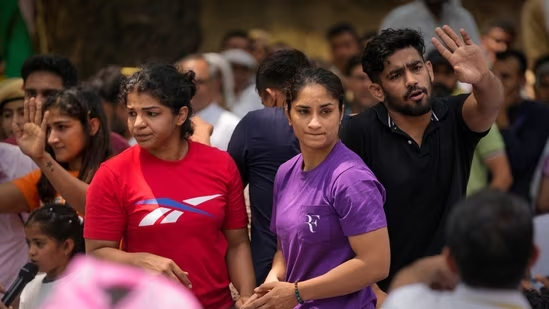Wrestlers grapple with layoff effect on return to competition
Double world championships bronze medallist Vinesh Phogat will return to competitive wrestling this week when she takes the mat at the Polyak Imre and Varga Janos Memorial tournament in Budapest starting Thursday. The fourth and last ranking series of the year will mark a comeback after 10 months.  PREMIUM
PREMIUM
Having missed the Zagreb (February), Alexandria (February) and Bishkek (June) ranking series as well as the Asian Championships this year, this event assumes great significance for Phogat as she will also be eying the World Championships later this year to qualify for her third successive Olympics. Phogat, who generally competes in the 53kg category, will take part in the 55kg in Budapest.
So, the return to competition will not be smooth. Experts believe that the 36-day sit-in protest that ended on May 28 would have taken a physical and mental toll on the top wrestlers. Sakshi Malik, Bajrang Punia, Sangeeta Phogat, Satyavart Kadiyan and Jitender Kumar are the others who led the protest demanding the arrest of former Wrestling Federation of India president, Brij Bhushan Sharan Singh, over sexual harassment.
The wrestlers are aware of their diminished powers. “As of now, my wrestling is as good as that of a young upstart. At this stage, even a rookie can beat us. The dedication you need in this sport is beyond imagination,” Punia, Tokyo Olympics bronze medallist, told HT in the final stages of the sit-in towards the end of May. “We don’t get the diet. We can’t rest. There is no sleep. Sometimes, I forget which day of the week it is. In wrestling, a day of missed training sets you back by a week,” he had said. By that yardstick the wrestlers, who missed at least 45 days of training from their second sit-in protest on April 23 till the truce at Union sports minister Anurag Thakur’s residence on June 7.
His assessment finds endorsement. “He is a four-time World Championships medallist and understands his body. It will be very tough for these wrestlers to get back to the level they were at,” Lalit Kumar, chief wrestling coach at Delhi’s Chhatrasal Stadium, who trains Tokyo Olympics silver medallist Ravi Dahiya, said.
“Such a long gap in wrestling is unheard of. Endurance is the first to go, then goes your strength and power, and with that confidence. For wrestlers, weight maintenance is non-negotiable. All these wrestlers would have gained fat and lost muscle. And we are not talking about slowing reflexes, loss of muscle memory, and waning technical prowess yet. It will take them at least 45 days to be able to play 2-3 bouts in a day,” added Kumar.
Sports science expert Aradhna Sharma, who has worked at the Army Sports Institute’s sports science department as an expert faculty for close to a decade, said the wrestlers will be experiencing the effect of long-term detraining. “The impact of such a long absence from training will play out in the form of loss of endurance and muscle strength. Endurance dips faster than muscle depletion. The cardiovascular strength, aerobic fitness, and VO2 max levels — all of which translate into endurance — fall after two weeks of non-training. Muscle mass and strength start to go down after three weeks. The wrestlers’ protest lasted roughly five weeks, so one can imagine the state of their bodies,” Sharma said.
The wrestlers spent nights on the pavement at Jantar Mantar during their protest. Punia said they slept for no more than four hours “on a good day”. “Even when I sleep, my mind is not at rest. I slip into sleep thinking about the next day. There are lawyers to deal with, supporters to talk to, media to handle. There’s so much pressure on us,” he had said.
An elite athlete, Sharma said, needs at least nine hours of quality sleep daily. “It varies from person to person, but nine hours is an ideal average. Lack of sleep slows down recovery, which kicks in muscle fatigue. The wrestlers would be feeling it now,” she said.
“Muscles need to be conditioned daily because it is very easy for the body to slip into a deconditioned state. It will take them at least 2-3 weeks to get back to the conditioned state. It is important that they hit the mat only after they are properly conditioned, to avoid injuries,” said Sharma.
The mental challenge will be no less. “Their confidence will certainly be quite low given their body will perhaps be in its worst shape. It is tough to assess their mental state, but it is safe to say their morale has taken a hit,” said a high-performance sports psychologist who didn’t wish to be identified.
Enjoy unlimited digital access with HT Premium
Subscribe Now to continue reading Start 14 Days Free Trial Already Subscribed? Sign In
Disclaimer: The copyright of this article belongs to the original author. Reposting this article is solely for the purpose of information dissemination and does not constitute any investment advice. If there is any infringement, please contact us immediately. We will make corrections or deletions as necessary. Thank you.







